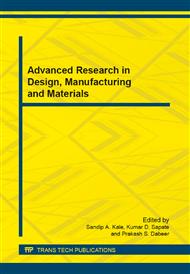p.59
p.65
p.71
p.77
p.83
p.89
p.97
p.105
p.111
Flow Stress Prediction of Ti-6Al-4V Alloy at Elevated Temperature Using Artificial Neural Network
Abstract:
Flow stress during hot deformation depends mainly on the strain, strain rate and temperature, and shows a complex nonlinear relationship with them. In this work, experimental flow stress have been predicted for Ti-6Al-4V alloy using isothermal uniaxial tensile tests ranging from 323K to 673K at an interval of 50K and strain rates 10-5, 10-4, 10-3 and 10-2 s-1. Based on the input variables strain, strain rate and temperature, a back propagation neural network model has been developed to predict the flow stress as output. The whole experimental data is randomly divided in two parts: 90% data as training data and 10% data as testing data. The artificial neural network enhanced with differential evolution algorithm is successfully trained based on the training data and employed to predict the flow stress values for the testing data, which were compared with the experimental values. Correlation coefficient for training and testing data is found to be 0.9997 and 0.9985 respectively. Based on the correlation coefficient, it indicates that predicted flow stress by using artificial neural network is in good agreement with experimental results.
Info:
Periodical:
Pages:
83-88
Citation:
Online since:
August 2014
Authors:
Keywords:
Price:
Сopyright:
© 2014 Trans Tech Publications Ltd. All Rights Reserved
Share:
Citation:


